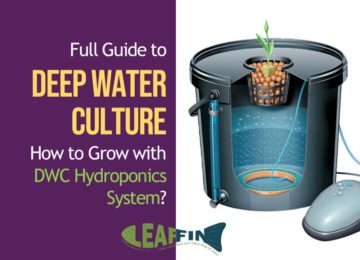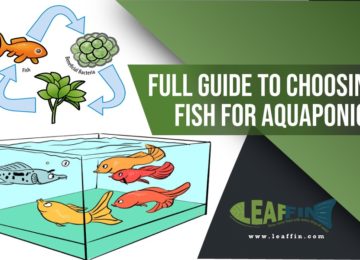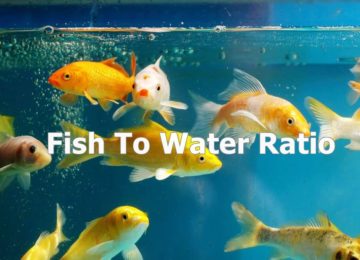The water is not just a mix of nutrients, minerals, and water. There are a number of organisms and compounds that your fish, plants, and bacteria need in an aquaponics system. One of the important aquaponic water parameters is dissolved oxygen (DO), which is required by
- Fish for respiration
- Plants for respiration, health, and strength of their roots and nutrient uptake
- Bacteria for nitrification and respiration
Let’s get into the details about the importance of DO for fish, plants, and bacteria
Table of Contents
Fish
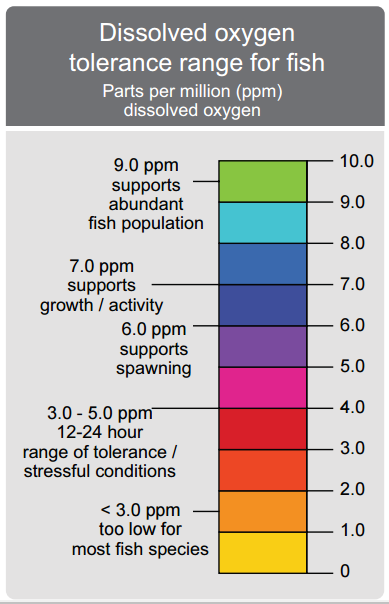
Different fish species need a varied range of dissolved oxygen. Normally, fish require 4–5 mg/liter of dissolved oxygen. Some species such as salmon and trout need higher levels of oxygen around 8mg/Lt. This is one of the important factors to consider while choosing fish for aquaponics.
The fish gasping for oxygen at the water surface is clear indication of lack of oxygen. This behavior of fish swimming close to the water surface to get air into the mouth is called piping. This emergency situation needs immediate action and attention.
The DO levels lower than 3 mg/l even kill a hardy fish. The dissolved oxygen (DO) that may be enough to support an adult fish can be depleted by the reproduction because of higher DO needs for eggs and juveniles.
The DO depletion can also lead to major changes in aquatic organisms composition in water bodies. The pollution-tolerant species like fly larvae and worms will replace the organisms that do not tolerate low DO levels like mayfly nymphs, beetle larvae, and stonefly nymphs. The problematic anaerobic organisms and nuisance algae that do not need oxygen may also grow aggressively in the water with low DO levels.
The lowest level of dissolved oxygen the fish survived for 24 hrs:
- Black Bass – 5.5 mg/L
- Northern Pike – 6.0 mg/L
- Yellow Perch – 4.2 mg/L
- Common Sunfish – 4.2 mg/L
- Black Bullhead – 3.3 mg/L
Read more about fish used in aquaponics here
Plants
Plants not only absorb oxygen through stems and leaves during respiration, but the roots also require oxygen. Most plants require high levels of Dissolved Oxygen (> 3 mg/liter) within the water.
Plant root systems need oxygen for the aerobic respiration that is an important process to releases metabolic energy for nutrient uptake and root growth.
Without oxygen, the plants can face
- Root-rot, that triggers fungus growth and even leads the roots to die.
- Poor ability to absorb a suitable amount of water and nutrients due to the accumulation of toxins.
- The plant’s root system loses a net amount of nutrient ions in anaerobic conditions.
- A calcium deficiency will occur in the shoot. This calcium deficit develops a calcium disorder such as tip burn that becomes severe under oxygen starvation conditions.
Plants need more oxygen when they are blooming the flowers as compared to their vegetative stage. This is mainly due to the temperature, nutrient uptake rates, and size of the plants’ roots.
Healthy roots with an adequate supply of oxygen can
- Selectively take up nutrient ions from the solution according to their requirement.
- Ensure roots have the energy to instantly absorb and carry nutrients, water, and mineral ions.
- Ensure healthy root tips are able to take enough calcium levels required for growth and development of new tissues.
Some water plants that grow in stagnant ponds, like Lotus or taro, can tolerate low levels of dissolved oxygen very well.
Nitrifying Bacteria
Bacteria require an appropriate amount of dissolved oxygen in the water to perform and effectively do their work. The bacteria perform nitrification to derive the energy through an oxidative reaction that combines oxygen with the nitrogen. The optimum DO levels for bacteria are 4–8 mg/liter. The process of nitrification stops if DO levels drop below 2 mg/liter.
Moreover, anaerobic bacteria grow in low DO conditions that process the useful nitrates back into toxic nitrogen molecules. This an anaerobic process is known as denitrification.
Check more about nitrifying bacteria here.
Effects of Other Parameters on Dissolved Oxygen
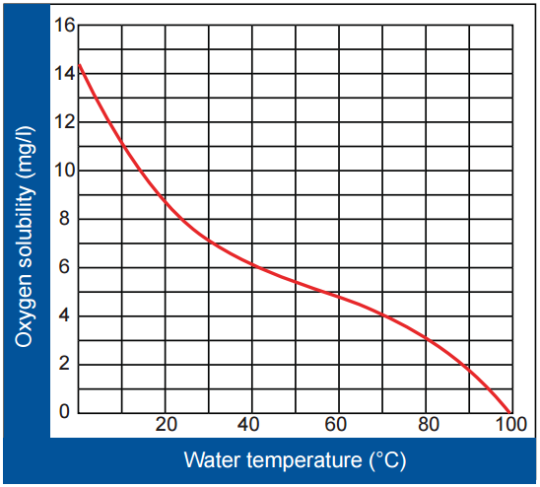
- The unique relationship between temperature and Dissolved Oxygen have a major impact on any aquaponics system. With an increase in the water temperature, the water holds less DO. Colder water has the ability to holds more oxygen than the warm water does. This is due to the enhanced molecular activity in the warm water that pushes the oxygen out of the spaces between molecules of the moving water.
- Water with a low PH holds lesser dissolved oxygen.
- With an increase in salts levels, the dissolved oxygen decreases exponentially. That is why the saltwater, at the constant temperature and pressure, holds approx 20% less dissolved oxygen than fresh water.
- With an increase in pressure, dissolved oxygen also increases. For any instance, if the dissolved oxygen concentration at the surface is at 100% air saturation, the water at 2-meters below the surface will only have 80% air saturation.
Oxygen, Temperature, and Metabolism
The rise in temperature also increases the oxygen demand of all organisms in aquaponics:
- There will be an increase in bacteria (biological) requirement for DO at higher stocking rates and higher temperatures. (Rate of metabolism doubles every 10 °C or 18 °F.)
- With the rise in temperature around the root system, the root respires at a higher rate resulting in an increase in oxygen requirement by the plant. The roots will require twice amount of oxygen for each 10 °C increase in temperature up to 86 °F (30 °C).
- A trout require 5-6 times more DO when the water temperature is 75 °F (24 °C) as compared to when the water temperature is at 41 °F (4 °C). Fish need higher DO levels to support the increased rate of metabolism.
However, DO itself decreases with rising temperature, e.g. An aerated solution holds oxygen concentration of 12ppm at 55 °F that drops to 9-10 ppm as it reaches a temperature of 68 °F (20 °C). The oxygen concentration in the solution is reduced to 7.5 ppm at 86 °F (30 °C).
This result in the depletion of Dissolved oxygen at a very high rate leading to stress in the overall system.
SEE ALSO: Role of Temperature for Aquaponics
Recommendations to ensure adequate DO levels
Higher levels of oxygenation leave the system more robust, less prone to failure, and better for fish welfare. So overall, you should add as much DO as possible to your aquaponic system. You can do this by following these recommendations.
- Do not overstock fish, and refrain from adding more than 20 kg of fish per 1000 liters of total water.
- The dynamic flow of water falling back into the container aerate the water very well and add DO.
- Using air pumps helps a lot. The recommended rate is 5–8 liters of air/min for each cubic water volume (meter). Use and place 2 air stones at opposite locations in the aquarium.
- Flood-and-drain cycles, air stones of external biofilters, cascading water and sump tanks help in aeration.
- The falling action of water provides aeration. So, make changes in your system design accordingly.
- In warm locations or during the hottest times of the year, increase aeration using air pumps or try to lower the temperature. (especially if raising delicate fish)
- Keep extra batteries and aeration systems as a backup to use during any power shutdown or equipment failure.

